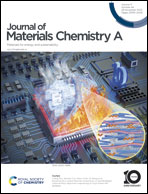3D-printed palladium/activated carbon-based catalysts for the dehydrogenation of formic acid as a hydrogen carrier†
Abstract
The development of structured catalyst supports to promote chemical process intensification is of great interest, and porous activated carbon (AC) is an excellent material to overcome this challenge. In addition, the current increasing hydrogen demand and its limitations in terms of transportation and storage require the development of novel approaches for the application of hydrogen. In this study, highly porous and robust 3D-printed patterned AC-based architectures were additive manufactured using the direct ink writing technology. Different AC inks containing a boehmite gel with no organic additives were rheologically characterized to select the most suitable ink for building AC supports, which were thermally treated to promote solid–solid contacts and increase their robustness (strength of ∼0.5 MPa) while maintaining a high porosity (86%). Subsequently, the AC supports were impregnated with a 5 wt% palladium (Pd) precursor to develop a 3D Pd/AC catalyst, which could generate hydrogen via the dehydrogenation of formic acid (FA), a very promising liquid organic hydrogen carrier, in a fixed-bed reactor. These 3D catalysts produced CO-free hydrogen from FA under ambient conditions with an FA conversion of 81% and hydrogen flow rate of 6 mL min−1. Furthermore, the long-term experiments in continuous mode operation showcased their good catalytic stability and recyclability. These results demonstrate that 3D Pd/AC catalysts exhibit a great potential to develop a new technology using FA as hydrogen carrier.



 Please wait while we load your content...
Please wait while we load your content...